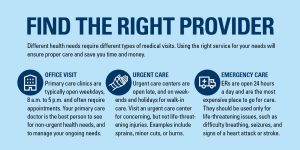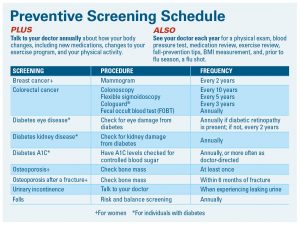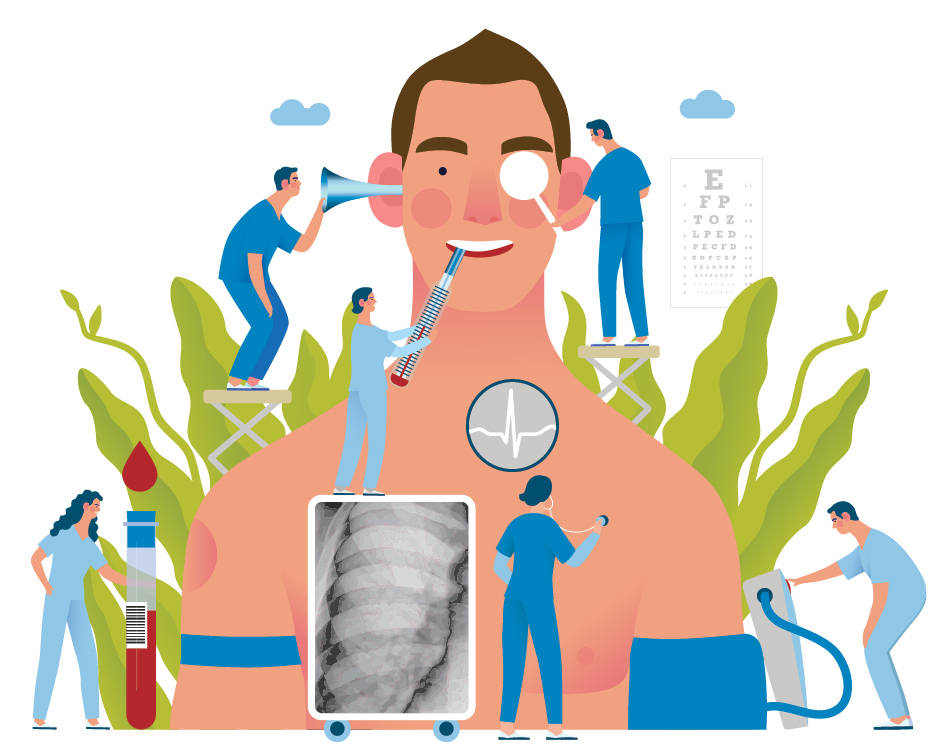Preventive screenings and routine doctor visits are critical to your health and wellness, as they can help you stay ahead of illness, chronic conditions and related complications. Here’s a look at some important checkups to get on your schedule.
PREVENTIVE SCREENINGS
Your health plan will typically cover annual exams and screening tests that can help you detect health issues. And the sooner you know about a concern, the sooner you can take action to address it.
No one is the same—your doctor will work with you to develop a screening schedule tailored for you based on your medical history and risks. A few common screening examples are listed below.
WELCOME TO MEDICARE VISIT
This visit is for new Medicare members and is covered during the first 12 months you have Medicare Part B. It helps to establish a baseline to compare any health changes over time. During the visit, your provider will typically:
• Go through your medical and family history.
• Review any health conditions you have and medications or supplements you take.
• Check your blood pressure, vision, weight and height.
• Make sure you’re up to date with preventive screenings and vaccines.
• Order any other tests you need based on your health history.
ANNUAL WELLNESS VISIT
Members who are not new to Medicare are still covered for an Annual Wellness Visit (AWV). At this visit your doctor can help you to create or update your personalized prevention plan. The visit typically involves:
• Going through your medical and family history.
• Making or updating a list of providers you see and medications and supplements that you take.
• Taking key measurements like height, weight and blood pressure.
• Checking for signs of new conditions, including dementia or depression.
• Making a list of risk factors and treatment options for you.
• Making a schedule for preventive services like immunizations and screenings. Your health plan will typically cover important screening tests that can help you detect and address health issues.
• Talking about advance care planning.
ANNUAL PHYSICAL EXAM
Whereas a Wellness Visit is more of a conversation about your health history and concerns, a Physical Exam is more hands-on. Your doctor will look, feel and listen to your body to decide if any other tests might be needed. A physical exam might include:
• Reviewing your medical and family history.
• Taking key measurements, such as height, weight and blood pressure.
• Checking your heart rate, breathing, and temperature.
• Listening to your heart and lungs.
• Examining your eyes, ears, throat, skin and stomach.
• Making a list of risk factors and treatment options for you.
• Talking about a schedule for preventive services like screenings and shots.

COLON CANCER SCREENING
Colon cancer screening should begin earlier in life, at age 45 for both men and women, according to the U.S. Preventive Services Task Force (USPSTF). A colonoscopy is recommended every 10 years up to age 75.
A colonoscopy is the most common form of testing, but other methods, including at-home tests, are also available. If an at-home test comes back positive, you would still need to have a diagnostic colonoscopy. It’s best to consult with your doctor about testing.
BREAST CANCER SCREENING
The American Cancer Society has encouraged women to return to routine mammograms, which have declined during the COVID-19 pandemic. Most women should receive a mammogram every two years, though some doctors recommend receiving one annually. Talk to your doctor about what is best for you.
DIABETES SCREENING (A1C TEST)
The A1C blood test indicates your average levels of blood glucose, with higher levels indicating increased risk of diabetes complications. A normal A1C level is less than 5.7 percent for someone without diabetes. Levels of 5.7 percent to 6.4 percent indicate prediabetes, and 6.5 percent or higher on two separate occasions results in a diabetes diagnosis.
Committing to routine checkups every year will ensure that you stay on track with treatments of existing conditions and avoid future ailments—or beat them through early detection. Learn more about preventive care here, or check out our previous thrive. articles on the subject.



